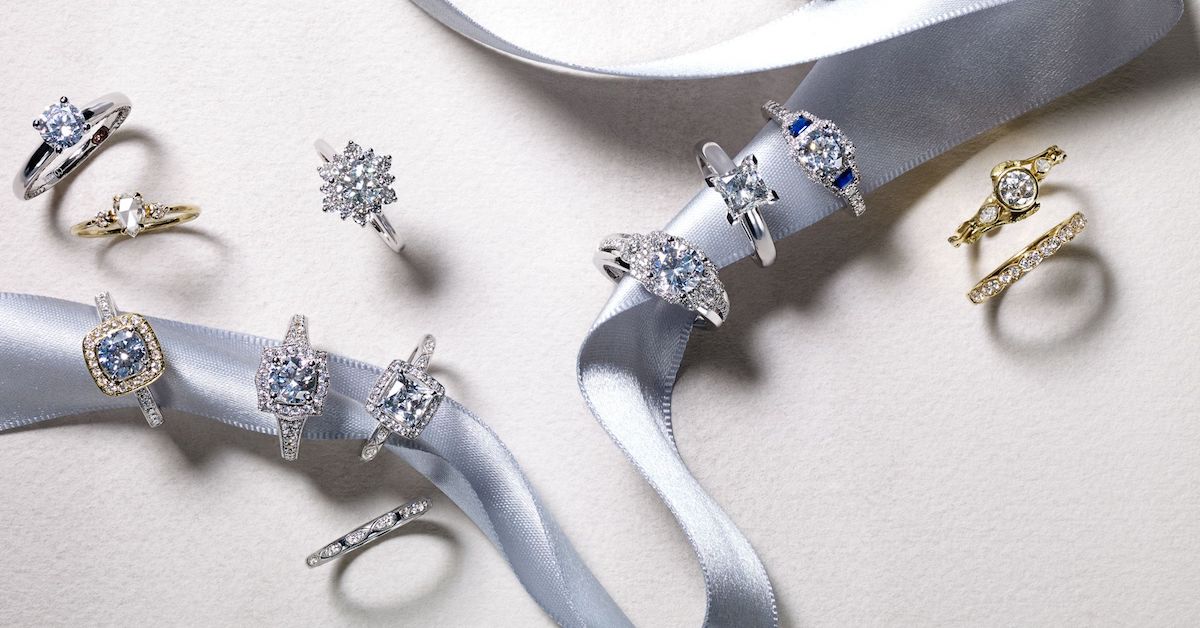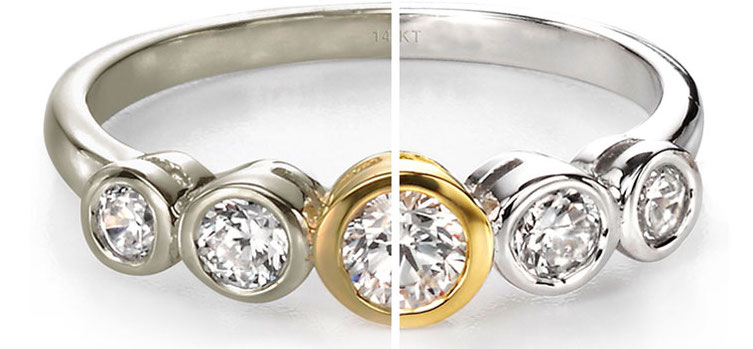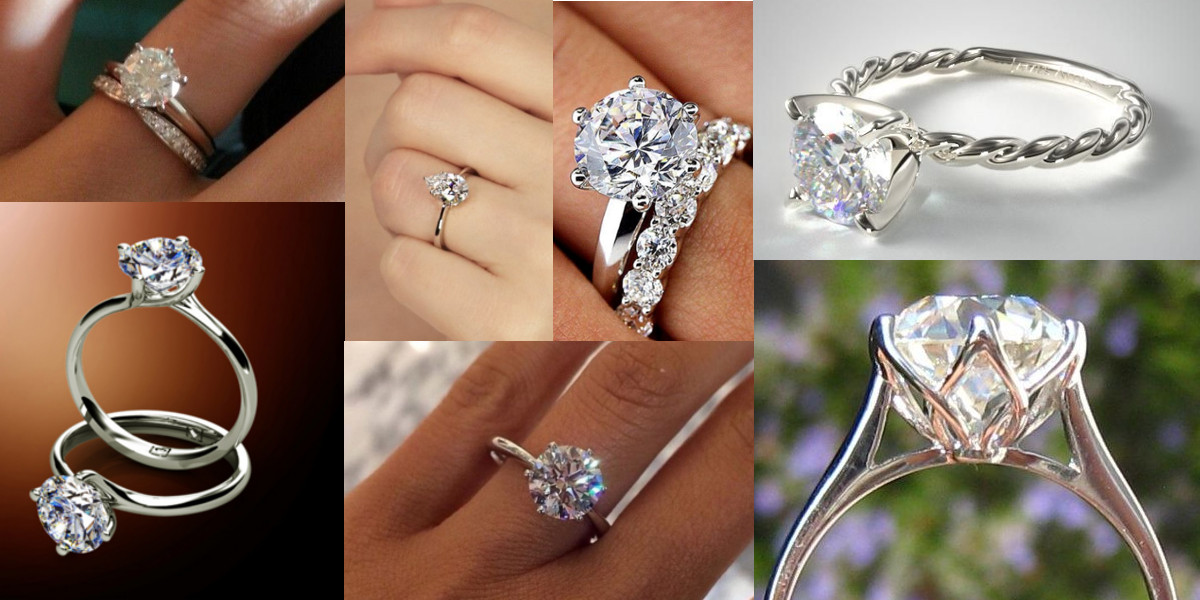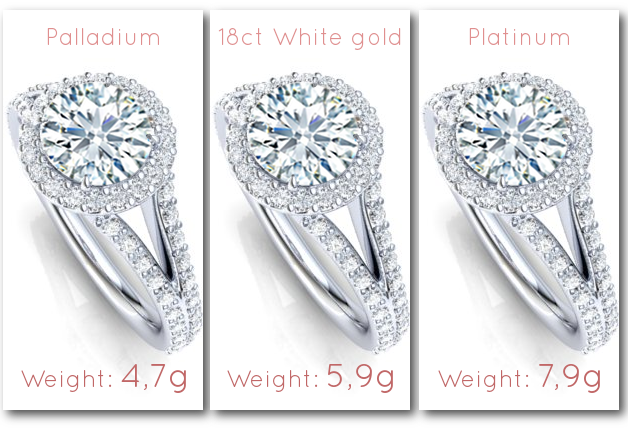
Your engagement ring journey doesn’t end after finalising a design and picking the perfect diamond or moissanite.
There’s one more crucial decision;
What’s the best metal to have an engagement ring made in?
Certain precious metals are all-around better choices for an engagement ring.
If you’re after a silverish hue for your engagement ring, your premium options are white gold, platinum and palladium.
Although these metals have a similar look at first glance, they vary significantly in terms of durability and price.
And since you don’t want to give or wear an engagement ring that ages in dog years, breezing over the metal choice is a bad idea.
To help you choose a precious metal that will make your unique long-term journey with your engagement ring enjoyable it’s worth looking at the most important pros and cons between your precious metal options.
1. Does the colour of white gold and platinum change?
As you’ve seen, natural gold as its mined has a rich yellow colour.
To get this colour to a shade of white/silver a concoction of metals including silver, copper and palladium are alloyed in.
As you can imagine, the yellow undertone can’t be overpowered completely, and the end result is not as white as you’d wish it to be.
To counter this jewellers plate white gold with a few microns of rhodium to improve the “whiteness” and sheen of a jewellery piece.
Rhodium is stunning, but disappointingly the plating starts wearing off in a few short months. Even if you were expecting this, you don’t want this gradual degradation in colour to be your focus when looking at your white gold engagement ring. And it is going to bug you, I promise.
Take a look at the stark difference in white gold colour of unplated white gold on the left, and a fresh rhodium plating on the right.

Spoiler alert: Rhodium is part of the platinum group of metals. So even white gold enjoys dressing up like whiter metals.
I’m unaware of jewellers that offer free rhodium plating for the life of the ring. Prices range from around R200 – R500 ($30+) and will be needed every 6 months to a year to keep a white gold engagement ring ring in tip-top shape.
Platinum and palladium are naturally a beautiful shade of white silver and don’t need any form of plating. Fifty years on, and the metal will still appear as white as the first day you laid eyes on the ring.
2. Weight
Platinum is more than 60% heavier than palladium, 30% heavier than white gold, and the weight difference is very obvious when you try on rings in these metals.
Personal preferences vary, but the vast majority of ladies prefer the presence created by the heft of platinum jewellery.
The only type of jewellery where unnecessary weight is best avoided would be chandelier earrings. Unless of course, you’re trying to get those earlobes to a shoulder length.
This weight difference is best explained with an example. Take a look at our Bea engagement ring, and its weight in the three white metals we’ve discussed;
With the design being identical you can see the significant differences in weight.
3. Purity

Apart from colour considerations, 100% pure gold is too soft to withstand the daily wear and tear an engagement ring goes through, so it’s always alloyed with other metals like silver, palladium, and copper to make a more durable for use in jewellery.
The karat of gold simply refers to the number of units out of 24 that are pure gold. The higher the karat, the higher the purity.
| Composition | Purity | |
| 18k White Gold | 18/24 Gold | 75% |
| 14k White Gold | 14/24 Gold | 58% |
| 9k White Gold | 9/24 Gold | 37.50% |
At the other end of the spectrum; 950 palladium and platinum are usually made in a 95% purity.
The 5% alloy used here is generally ruthenium – which is also a platinum group metal. The sole reason for adding ruthenium is to slightly soften up the platinum to make it workable by a goldsmith.
So, with no lesser metals being alloyed in, the final mixture is made up entirely of platinum group metals.
4. Engagement ring wear & tear.
Let’s dispel a myth; no precious metal is scratch-proof.
Some are simply more vulnerable to the hard-knock life than others.
Engagement rings come into contact daily with a variety of hard and often coarse surfaces.
Due caution helps but only takes you so far.
But, that doesn’t mean you have to spend your days worrying about damaging your engagement ring every time you move.
The first step to a durable ring that can weather everyday life is choosing a strong base metal as a foundation.
That would be platinum or palladium.
Gold’s distinctly soft and malleable nature has made it a goldsmith’s preference for centuries. Unfortunately, these very same characteristics compromise the strength and durability of a white gold ring.
Jewellery manufacturing has changed a lot over the past few decades thanks to advances in jewellery 3D printing. Fine design details can now be printed in a wax model and cast in a single intricate piece without a goldsmith having to rely on bending and shaping fine metal rods for design intricacies.

This brings us to one of the most fascinating differences between these metals.
When a white gold jewellery piece is scratched a minute piece of metal is generally worn off. It erodes.
So, over the years the bottom of a gold ring will most probably wear thin, and that may lead to some unwanted bending eventually.
Platinum and palladium on the other hand have a sort of smear effect where the metal is just slightly displaced. It can be polished back into place!
Regardless of metal, 99% of scratches aren’t train smashes and can be easily polished out by a jeweller.
The benefit here is that your platinum or palladium engagement ring will not be in desperate need of a touch-up polish every couple of months.
Palladium and Platinum are better suited for use in everyday jewellery such as diamond engagement rings.
5. Safeguarding diamonds and gemstones.
Regardless of how well you take care of your engagement ring, there will be bumps every now and then. And these events can bend claws and prongs to varying degrees, creating the risk that a diamond dislodges.
Knowledgeable design and expert craftsmanship surely help to ensure that a ring can withstand minor encounters… But a hard blow is bound to happen some time. And then, both you and I, want the strongest metal to protect the diamonds as best as possible in that dreaded moment.
Also, don’t overlook the accumulation of seemingly light daily bumps that slowly move the prongs that secure your diamonds out of place.
The hardness of platinum and palladium keeps your gemstones safer.
As a bonus; the hardness of platinum and palladium allows for the claws holding your diamond in place to be slightly smaller/daintier than you’d find on a white gold ring. Delicate prongs and claws make your centre diamond appear larger and just gives an engagement ring a more refined and elegant overall look.
We recommend that our customers visit us at least once a year to have their engagement ring cleaned thoroughly, and to ensure all diamonds are still secure.
6. OK, What About Platinum vs Palladium?
Palladium is ten times rarer than platinum.
You can stack all the palladium that has ever been mined into a standard double-garage! That seems like a good life goal.
Quite a few jewellers don’t work in palladium at all. It’s a very difficult metal to master and you need palladium specific specialised equipment. You don’t know where life takes you and having a platinum ring that can be sized and repaired by most jewellers might come in handy.
The platinum group metals are used in massive industries ranging from chemotherapy, fuel cells, motor vehicle catalysts, ceramic capacitors and plastics manufacturing.
As different industries find a use for one or the other demand and prices can drop or soar. These price differences aren’t materially driven by the utility for jewellery.
7. Price differences.
Per gram, palladium is three times more expensive than platinum at the time of writing.
For decades palladium was selling at a fraction of the platinum price, but with the surging demand from the motor industry, palladium has rocketed past platinum and doesn’t seem to be slowing down.
[Update: Platinum’s price has already started ticking up again, but it still has my vote.]
8. Prestige.
When it comes to reputation, prestige and perceptions; platinum is sitting firmly on the throne. And that’s not changing any time soon.
It’s simply been the default choice for high-end diamond jewellery for decades.
Every single ring we’ve manufactured with a price tag north of R200 000($15 000) has been in platinum.

Each to his own… but fancy doesn’t hurt, does it?
So, what’s the best metal for a diamond or moissanite engagement ring?
I can’t think of a single reason to chose palladium or white gold over platinum at this stage.
From superior durability to the ring of its name; it’s a no-compromise choice.
Well, congratulations, now you’ve done your research!
Where to from here?
Words and photos don’t do these luxurious metals any justice.
Do us both a favour and visit us to see and feel these noble metals in person, on your hand, compared to your unique skin tone.
With over 90% of our work being in platinum and palladium, it’s our expertise – and our quality speaks for itself.
We’d love to work with you in creating jaw-dropping, high-quality custom jewellery pieces.
Send me a mail at info@poggenpoel.com, and we can take it from there.
Questions? I’m here to help.
Kind Regards
Johan Poggenpoel
T; 012 111 0525 (Pretoria) | 010 020 6811 (Johannesburg)
E; info@poggenpoel.com
Instagram:https://www.instagram.com/poggenpoeljewel/
Facebook; www.facebook.com/poggenpoel



